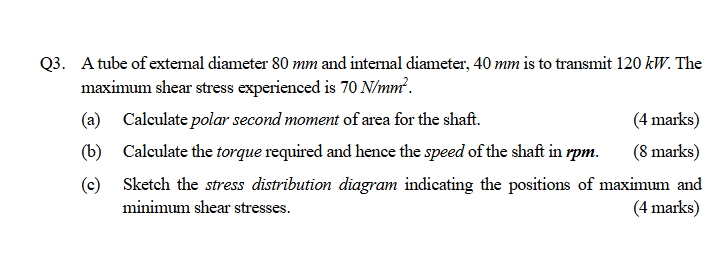A tube of external diameter 80 mm and internal diameter, 40 mm is to transmit 120 kW. The maximum shear stress experienced is 70 N/mm². (a) Calculate polar second moment of area f... A tube of external diameter 80 mm and internal diameter, 40 mm is to transmit 120 kW. The maximum shear stress experienced is 70 N/mm². (a) Calculate polar second moment of area for the shaft. (b) Calculate the torque required and hence the speed of the shaft in rpm. (c) Sketch the stress distribution diagram indicating the positions of maximum and minimum shear stresses.

Understand the Problem
The question describes a tube with given external and internal diameters transmitting a certain power with a specified maximum shear stress. It asks to calculate the polar second moment of area, torque, and speed of the shaft. Additionally, a stress distribution diagram needs to be sketched.
Answer
(a) $J \approx 3.77 \times 10^6 \text{ mm}^4$ (b) $T \approx 6597.5 \text{ Nm}$, $N \approx 173.74 \text{ rpm}$ (c) Linear stress distribution from $35 \text{ N/mm}^2$ to $70 \text{ N/mm}^2$
Answer for screen readers
(a) The polar second moment of area is approximately $3.77 \times 10^6 \text{ mm}^4$. (b) The torque required is approximately $6597.5 \text{ Nm}$, and the speed of the shaft is approximately $173.74 \text{ rpm}$. (c) Stress distribution diagram: A linear variation from $35 \text{ N/mm}^2$ at the inner radius (20 mm) to $70 \text{ N/mm}^2$ at the outer radius (40 mm).
Steps to Solve
- Calculate the polar second moment of area $J$
The polar second moment of area $J$ for a hollow shaft is given by: $$ J = \frac{\pi}{32}(D^4 - d^4) $$ where $D$ is the external diameter and $d$ is the internal diameter. Given $D = 80 \text{ mm}$ and $d = 40 \text{ mm}$, we can calculate $J$: $$ J = \frac{\pi}{32}(80^4 - 40^4) = \frac{\pi}{32}(40960000 - 2560000) = \frac{\pi}{32}(38400000) \approx 3770000 \text{ mm}^4 $$
- Calculate the torque $T$
The relationship between shear stress $\tau$, torque $T$, radius $r$, and polar second moment of area $J$ is: $$ \tau = \frac{Tr}{J} $$ The maximum shear stress $\tau_{max}$ occurs at the outer radius $R = D/2$. Therefore, $R = 80/2 = 40 \text{ mm}$. Rearranging the formula to solve for $T$: $$ T = \frac{\tau_{max} J}{R} $$ Given $\tau_{max} = 70 \text{ N/mm}^2$, $J \approx 3770000 \text{ mm}^4$, and $R = 40 \text{ mm}$: $$ T = \frac{70 \times 3770000}{40} = 6597500 \text{ Nmm} = 6597.5 \text{ Nm} $$
- Calculate the speed $N$ in rpm
The power $P$ is related to torque $T$ and angular speed $\omega$ by: $$ P = T\omega $$ where $\omega = 2\pi N/60$, and $N$ is the speed in rpm. Therefore, $$ P = T \times \frac{2\pi N}{60} $$ Rearranging to solve for $N$: $$ N = \frac{60P}{2\pi T} $$ Given $P = 120 \text{ kW} = 120000 \text{ W}$ and $T = 6597.5 \text{ Nm}$: $$ N = \frac{60 \times 120000}{2\pi \times 6597.5} \approx \frac{7200000}{41442.5} \approx 173.74 \text{ rpm} $$
- Sketch the stress distribution diagram
The shear stress varies linearly from the inner radius to the outer radius. The minimum shear stress occurs at the inner radius, and the maximum shear stress occurs at the outer radius. $$ \tau_{min} = \frac{T r_{min}}{J} = \frac{6597500 \times 20}{3770000} \approx 35 \text{ N/mm}^2 $$ $$ \tau_{max} = 70 \text{ N/mm}^2 $$ The stress distribution diagram will be a straight line from $\tau_{min}$ at $r = 20 \text{ mm}$ to $\tau_{max}$ at $r = 40 \text{ mm}$.
(a) The polar second moment of area is approximately $3.77 \times 10^6 \text{ mm}^4$. (b) The torque required is approximately $6597.5 \text{ Nm}$, and the speed of the shaft is approximately $173.74 \text{ rpm}$. (c) Stress distribution diagram: A linear variation from $35 \text{ N/mm}^2$ at the inner radius (20 mm) to $70 \text{ N/mm}^2$ at the outer radius (40 mm).
More Information
The polar second moment of area describes the resistance of an object to torsional deformation. Torque is a twisting force that causes rotation. The speed of the shaft in revolutions per minute (rpm) indicates how many complete rotations the shaft makes in one minute.
Tips
A common mistake is converting units incorrectly. For example, the power is given in kW but must be converted to Watts before using it in calculations. Also, the radius should be in the same units as the length (mm), and the torque should be in consistent units (Nm) before using them in formulas. Another common mistake is using diameter instead of radius in calculations.
AI-generated content may contain errors. Please verify critical information